INCA UNIT LESSONS
The Inca
The Inca Empire was centered in Peru and ruled over much of the west coast of South America from the 1400s to the time of the Spanish arrival in 1532. This wide ranging empire did not have the wheel, iron tools, or a writing system, but its complex government and system of roads created a society where everyone had a job, a home, and something to eat.
The emperor of the Inca was known as the Sapa Inca. The first Sapa Inca was Manco Capac. He founded the Kingdom of Cuzco around 1200 CE. The city of Cuzco would remain the capital of the empire as it expanded in the coming years. The Inca expanded into a great empire under the reign of Pachacuti. Pachacuti created the Inca Empire which the Inca called the Tawantinsuyu. At its height, the Inca Empire had an estimated population of over 10 million people.
The Inca were conquered by the Spanish and conquistador Francisco Pizarro in 1533. The empire was already severely weakened by civil war and diseases such as smallpox when Pizarro arrived.
The emperor of the Inca was known as the Sapa Inca. The first Sapa Inca was Manco Capac. He founded the Kingdom of Cuzco around 1200 CE. The city of Cuzco would remain the capital of the empire as it expanded in the coming years. The Inca expanded into a great empire under the reign of Pachacuti. Pachacuti created the Inca Empire which the Inca called the Tawantinsuyu. At its height, the Inca Empire had an estimated population of over 10 million people.
The Inca were conquered by the Spanish and conquistador Francisco Pizarro in 1533. The empire was already severely weakened by civil war and diseases such as smallpox when Pizarro arrived.
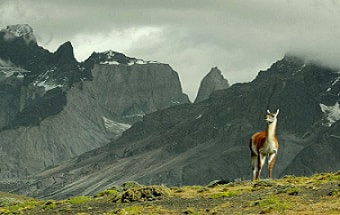
1 INCA GEOGRAPHY
The Maya and the Aztec cultures arose in Mesoamerica, in what is now Mexico and Central America. In South America another great empire arose. That empire belonged to the Inca. South America was also home to several civilizations before the Inca built their empire. These civilizations provided a foundation for the Inca. When building their empire, the Inca borrowed from the scientific and cultural achievements - such as farming techniques and craft-making skills - of those earlier cultures.
The Maya and the Aztec cultures arose in Mesoamerica, in what is now Mexico and Central America. In South America another great empire arose. That empire belonged to the Inca. South America was also home to several civilizations before the Inca built their empire. These civilizations provided a foundation for the Inca. When building their empire, the Inca borrowed from the scientific and cultural achievements - such as farming techniques and craft-making skills - of those earlier cultures.
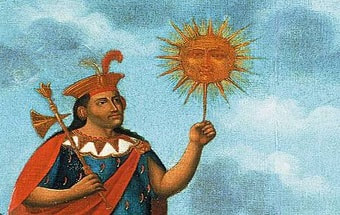
2 INCA EARLY SETTLERS
The Inca were not the first people to live in the Andes. As early as 5000 BCE, villagers were farming the western part of South America. Like other ancient cultures, those early settlers worshiped many gods. As time went by, they learned how to work metals and they made beautiful pottery. Eventually, their towns grew into cities. With others, the Inca began as just one of many small South American tribes.
The Inca were not the first people to live in the Andes. As early as 5000 BCE, villagers were farming the western part of South America. Like other ancient cultures, those early settlers worshiped many gods. As time went by, they learned how to work metals and they made beautiful pottery. Eventually, their towns grew into cities. With others, the Inca began as just one of many small South American tribes.
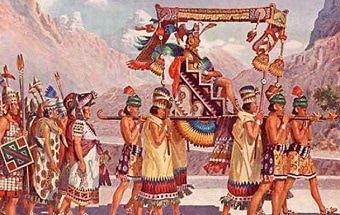
3 INCA THE SAPA INCA
The Sapa Inca was the all-powerful emperor and leader of the Inca people. Inca means “emperor.” Sapa Inca means “the only emperor.” The Sapa Inca ruled everything and owned everything. The Inca was not just a ruler; he was believed to be a descendant of the sun god, Inti. As a descendant of the gods, everything the Sapa Inca touched was considered holy and preserved.
The Sapa Inca was the all-powerful emperor and leader of the Inca people. Inca means “emperor.” Sapa Inca means “the only emperor.” The Sapa Inca ruled everything and owned everything. The Inca was not just a ruler; he was believed to be a descendant of the sun god, Inti. As a descendant of the gods, everything the Sapa Inca touched was considered holy and preserved.
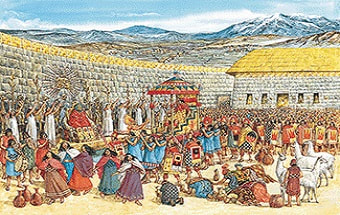
4 INCA GOVERNMENT
By 1500 CE, the Inca Empire was huge. It stretched for 2500 miles from the north to the south and had a population of around 12 million people. In order to manage and maintain such a large empire, the Inca needed a sophisticated and organized government. Because the Inca empire was so large, its government was large as well.
By 1500 CE, the Inca Empire was huge. It stretched for 2500 miles from the north to the south and had a population of around 12 million people. In order to manage and maintain such a large empire, the Inca needed a sophisticated and organized government. Because the Inca empire was so large, its government was large as well.
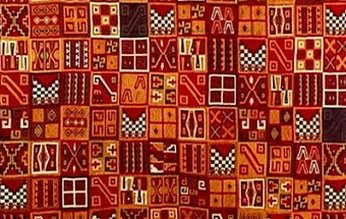
5 INCA DAILY LIFE
Inca society had two main social classes - an upper, elite class and a lower class made up of commoners. The king, priests, and government officials made up the Inca upper class. Nearly 90 percent of all Inca were commoners. The life of common people was highly regulated and all commoners worked hard to support the Inca state.
Inca society had two main social classes - an upper, elite class and a lower class made up of commoners. The king, priests, and government officials made up the Inca upper class. Nearly 90 percent of all Inca were commoners. The life of common people was highly regulated and all commoners worked hard to support the Inca state.
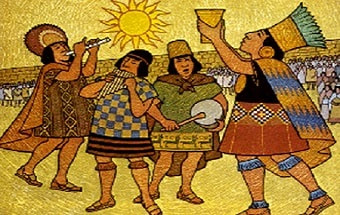
6 INCA RELIGION
As with so many other ancient cultures, religion for the Inca was inseparable from their history, their politics, and their society in general. Religion played a large part in their everyday life. From marriages to seasonal success on the farm, from how the government was organized to how a person was buried, all areas of Inca life were closely connected to their religious beliefs.
As with so many other ancient cultures, religion for the Inca was inseparable from their history, their politics, and their society in general. Religion played a large part in their everyday life. From marriages to seasonal success on the farm, from how the government was organized to how a person was buried, all areas of Inca life were closely connected to their religious beliefs.
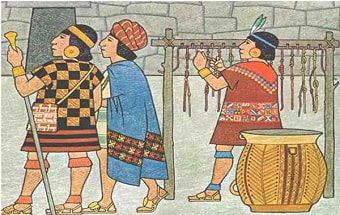
7 INCA SCIENCE, INNOVATION & TECHNOLOGY
The Inca didn't have a lot of technologies we often consider important to advanced societies. They didn't use the wheel for transport. They didn't have a writing system for records. They didn't even have iron for making tools. How did they create such an advanced Empire? The Inca were problem-solvers. When faced with a problem, they came up with effective solutions.
The Inca didn't have a lot of technologies we often consider important to advanced societies. They didn't use the wheel for transport. They didn't have a writing system for records. They didn't even have iron for making tools. How did they create such an advanced Empire? The Inca were problem-solvers. When faced with a problem, they came up with effective solutions.


